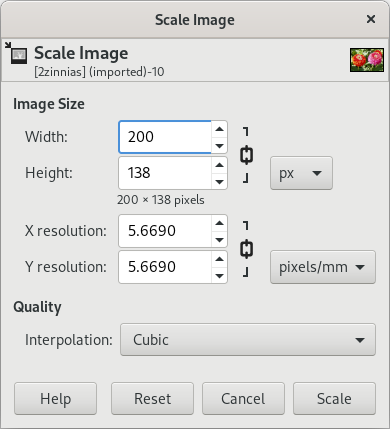您有一个巨大的图像,可能来自数码相机,并且您想调整它的大小,以便它在网页、在线页面或电子邮件消息上很好地显示。
The first thing that you might notice after opening the image, is that GIMP opens the image at a logical size for viewing. If your image is very large, like the sample image, GIMP sets the zoom so that it displays nicely on the screen. The zoom level is shown in the status bar at the bottom of the image window. This does not change the actual image.
The other thing to look at in the title bar is the mode. If the mode shows as RGB in the title bar, you are fine. If the mode says Indexed or Grayscale, read the 第 4.7 节 “更改模式”.
Select → . You can right click on the image to open the menu, or use the menu along the top of the Image window.
用于在屏幕上显示图像的尺寸单位是像素。您可以看到该对话框有两个部分:一个用于宽度和高度,另一个用于分辨率。分辨率仅适用于打印,在显示器或移动设备上显示时对图像的大小没有影响。原因是不同的设备具有不同的像素大小,因此,在具有特定物理尺寸的一个设备(例如智能手机)上显示的图像可能以完全不同的尺寸在其他设备(例如 LCD 投影仪)上显示。对于在屏幕上显示的图像,您可以忽略分辨率参数。同样的原因,不要在高度/宽度字段中使用除像素以外的任何尺寸单位。
If you know the desired width, enter it in the dialog at the top where it says Width. This is shown in the figure above. If you don't have such a number in mind, choose an appropriate width for the desired use. Common screen sizes range between 600 pixels for simpler phones and 1920 pixels for an HD screen.
当您更改图像的一个尺寸时,GIMP会按比例更改另一个尺寸。要更改其他尺寸,请参阅第 4.5 节 “裁剪图像”。请记住,当您任意更改两个维度时,图像可能会被拉伸或压扁。




